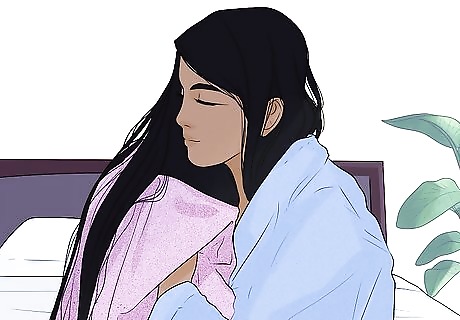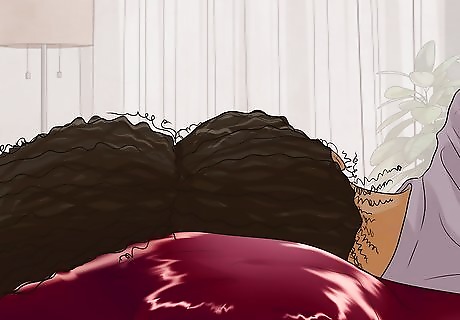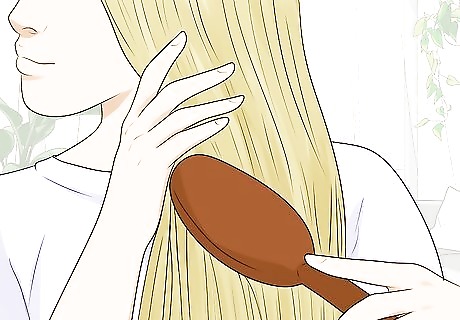
views
- Dry your hair completely before going to sleep, as water makes your hair vulnerable to damage. Wash your hair in the morning if possible, not at night.
- Use silk or satin pillowcases to protect your hair from damage and knotting. Alternatively, wrap your hair in a silk or satin hair wrap for overnight protection.
- Braid your hair loosely before bed to keep it contained and tangle-free.
- Use hair treatments like a leave-in conditioner or an overnight hair mask to strengthen and protect your hair while you sleep.
Sleep with completely dry hair.

Wet hair is more prone to damage and breakage during sleep. This is the primary rule for sleeping with long hair! Water weakens the hydrogen bonds in the protein that makes up your hair (keratin), leaving it more vulnerable to damage than dry hair. It leads to increased stretching, deforming, and friction. If you usually wash your hair at night, dry it fully before climbing into bed. Use a microfiber towel to dry your hair if necessary. They gently speed up water absorption while leaving less of a frizzy effect in their wake. One best practice for hair health at any time of day is to avoid drying it intensely on high heat. Use a lower setting and keep the hair dryer about 6 inches from your hair. If you must sleep with wet hair, use a satin pillowcase and fan your hair out over the pillow so it'll dry evenly. Don't tie it up because the hair tie will just create more friction.
Wash your hair in the morning.

You won't need to dry your hair before bed if you do it early in the day. This simple switch to your routine can save you the hassle of having to dry your hair completely before bed. Just hop in the shower in the morning and wash your hair to ensure that no towels or hairdryers are necessary when it’s time for bed. If possible, time your showers to that your hair will have a few hours to gently air dry before you head to bed. Give your hair a quick blast of cold water at the end of each shower, too. The cold water helps seal moisture into your hair, giving it a healthier overall look.
Sleep with a silk or satin pillowcase.

Regular cotton pillowcases are more likely to damage your hair. Cotton pillowcases cause an increase in friction when you toss and turn at night, leading to increased knots, frizz, breakage, and even hair loss. By switching to silk or satin pillowcases, you’re also protecting your hair health long-term. Silk and satin are similar in texture; the main difference is that satin is a weave, whereas silk is a natural fiber fabric. They have the same protective effect on hair, so either is a great choice! Cotton pillowcases also have a tendency to absorb moisture from your hair. Even if you’re a peaceful sleeper whose head barely moves at night, your cotton pillowcase may be draining your hair’s natural moisture.
Use a silk or satin hair wrap.

Hair wraps protect your hair from friction and damage overnight. If you’d rather not switch to silk or satin bedding, wrapping up your hair in a silk or satin hair wrap is an equally effective alternative. It’ll prevent your hair from dragging across a cotton pillowcase for hours, suffering damage and breakage in the process. Plus, the smooth caps create an environment that lets your hair baste in its own natural oils throughout the night, which also improves hair health in the long run.
Brush your hair at bedtime.

Small tangles can easily turn into full-grown knots overnight. The more baby knots you bring to bed with you, the messier your hair will be (and harder it’ll be to detangle) in the morning. Why seed the tumbleweed? Instead, give your long locks a gentle brush with a soft-bristled brush before bed.
Braid your hair loosely before bed.

Braiding keeps your hair contained to prevent damage. If you don’t like the idea of putting your long hair in a cap or scarf, consider braiding it instead. After brushing your hair before bed, arrange it into a simple, loose braid. Don't braid it tightly; regularly sleeping with a tightly pulled-back style (such as a ponytail, braid, bun, or tight headband) can cause hair damage or loss. It’s safe to wear pulled-back styles like buns and braids for bed so long as your hair isn’t being pulled tightly from your scalp. Check to make sure your hair feels loose and comfortable before bed! Avoid continually wearing tight, pulled-back styles during the day as well. This can increase hair thinning over time and lead to a condition known as “traction alopecia.”
Hold your hair with a satin scrunchie.

Scrunchies help prevent damage to the ends of your hair over time. By comparison, elastic hairbands can strain your hair and scalp because they pull your hair back so tightly. This friction causes frizz and breakage over time, especially when you wear elastic hairbands at night. Switch to a satin scrunchie, which can keep your hair contained while also preventing friction. Satin scrunchies are also less likely to leave your hair looking visibly dented in the morning, which in turn cuts back on the time you’ll need to style it!
Apply essential oil to the ends of your hair.

Essential oil protects the ends of your hair from damage overnight. Did you know that the ends of your hair typically take the brunt of the damage from friction as you sleep? The tips of your long hair often get crushed when you move around. To counteract the damage, rub a few drops of essential oil into your hair, focusing on the ends. Choose from natural oils like argan oil, almond oil, jojoba oil, or coconut oil. Essential oils can also seal your hair to prevent split ends from forming. Don’t rub the essential oil into your scalp or the roots of your hair, especially if your hair is naturally on the oily side. This process is mainly to protect your tips!
Use an overnight conditioner.

Leave-in conditioner can strengthen and hydrate your hair as you sleep. Simply apply a spritz or two of leave-in conditioner to your hair before bed and gently work it through your hair. For maximum effectiveness, look for a conditioner designed for nighttime repair and use on dry hair. Choosing your leave-in conditioner based on your specific hair needs is also a good idea. For example, pick a moisturizing conditioner if your hair tends to dry out overnight. On the other hand, if it gets oily easily, look for a lighter formula with botanical extracts. Use a cap, scarf, or braiding to keep your hair well-contained and to keep from transferring the product to your pillowcase.
Apply a hair mask before bed.

Using hair masks overnight can give your long hair a fortifying boost. Choose a hair mask suitable for overnight use, and apply the mask before combing your hair and getting into bed. Just like overnight conditioners, look for an overnight hair mask designed to meet your hair’s specific needs, whether it’s a hydrating mask for dry hair or a lighter protective mask for oily hair. It’s also a good idea to use a cap or scarf to contain your hair when you use a hair mask and prevent the product from getting onto your bedding. Use this method periodically as a complement to your regular nighttime hair routine, not as a nightly occurrence. For dry hair, 1 or 2 times a week is more than enough. For oily hair, do treatments every 2 weeks.
Turn on a fan or air conditioning at night.

Sleeping in hot temperatures can be unhealthy for your hair. You naturally begin to sweat when there’s too much heat in the air, and excess sweating can worsen the tangles and knots in your hair. Turn the air conditioning to a cool, comfortable temperature if your bedroom tends to get warm at night, or move a fan into the room. The less you sweat, the healthier your hair will be! It’s also easier to fall asleep comfortably in cool temperatures, so you’re more likely to get a good night’s sleep overall. You could also move a humidifier into your bedroom if it tends to have dry air. Adding moisture to the air will help your hair stay moisturized overnight.



















Comments
0 comment